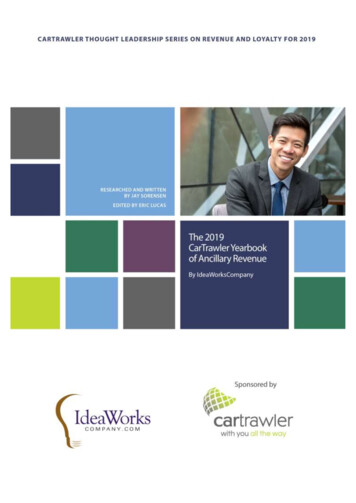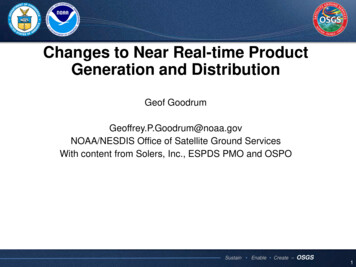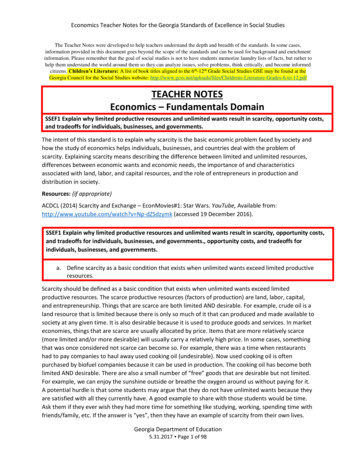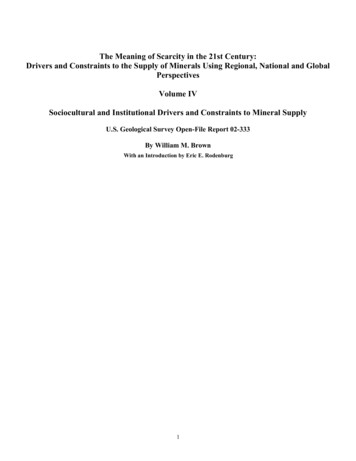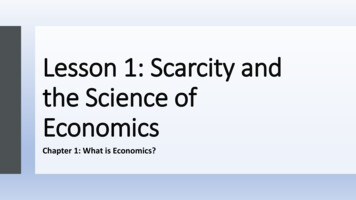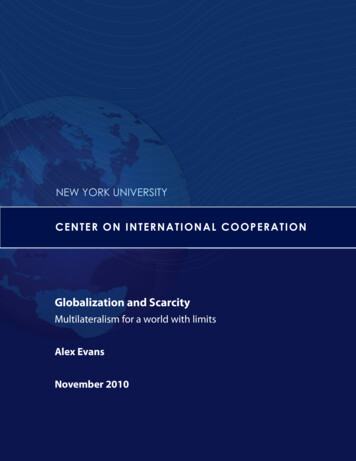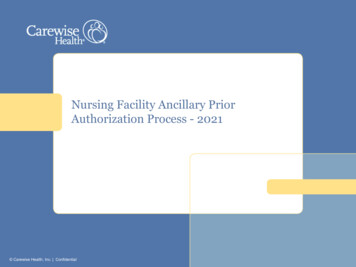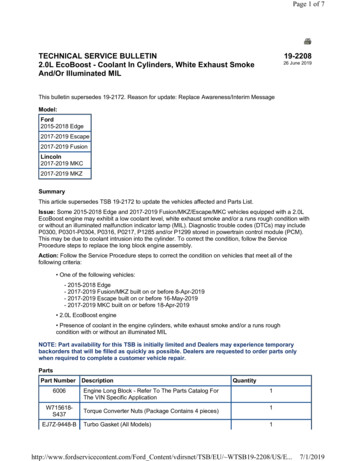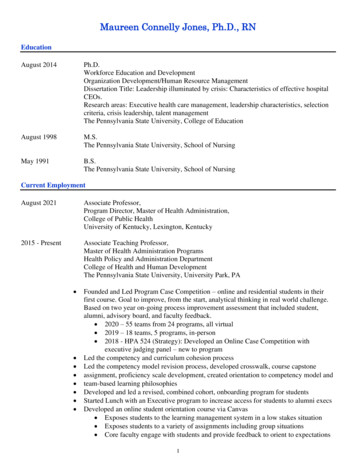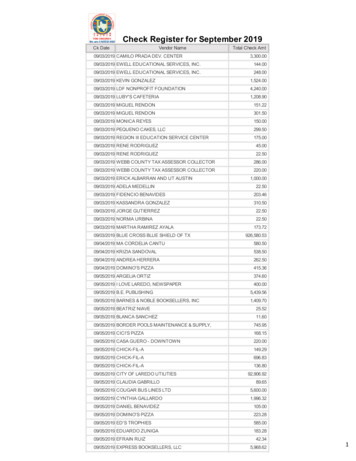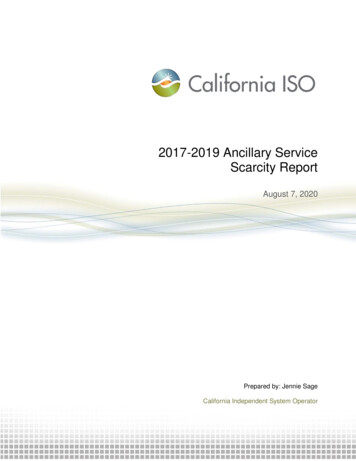
Transcription
2017-2019 Ancillary ServiceScarcity ReportAugust 7, 2020Prepared by: Jennie SageCalifornia Independent System Operator
2017-2019 A/S Scarcity ReportMPP/Market Analysis and Forecasting2
2017-2019 A/S Scarcity ReportI.IntroductionThrough its markets, the California Independent System Operator Corporation (ISO) procuresancillary services (A/S), including regulation services (regulation up and regulation down) andoperating reserves (spinning and non-spinning reserves), to meet NERC and WECC reliabilitystandards and to support reliable electric system operations. In addition to the ISO system-wideprocurement requirements, the ISO establishes minimum A/S procurement requirements in someof the A/S sub-regions, such as the ISO system (the entire CAISO excluding the interties), SP26,NP26 and expanded sub-regions.On December 1, 2010, the ISO implemented an A/S scarcity pricing mechanism in its markets. Thescarcity pricing mechanism is triggered when there is insufficient A/S supply to meet the targetedrequirement. Under this mechanism, the price of the scarce A/S will automatically rise to a predetermined scarcity price, as described in the ISO tariff. 1 For the first three years of A/S scarcitypricing, the ISO published an annual report reviewing the events that occurred and conducted anassessment that no changes were needed to the pricing mechanism. 2 This report presents thedetails and impacts of the scarcity events that occurred in 2017, 2018 and 2019 and fulfills therequirement in Tariff Section 27.1.2.3 that the ISO review the scarcity pricing mechanism everythree years.II.Frequency of Scarcity EventsTable 1 below shows the frequency of the 2017, 2018 and 2019 scarcity events by year, A/S regionand A/S type. All scarcity events occurred in the real-time market (RTM) with the exception oftwo events of regulation up scarcity in 2019 in the integrated forward market (IFM) 3.Table 1: Count of Scarcity Events by Year, A/S region and ServiceA/S RegionandServiceCAISO ExpandedRegulation UpRegulation DownSpinNon-SpinNP26 ExpandedRegulation UpRegulation DownYear201720182019129213182528314182615318See the ISO tariff section 27.1.2.3.The 2014-2016 report is located x?GroupID 0DB07C0D-A0F9-4B81-BD664903D05798D0123The IFM scarcity event occurred on 5/5/2019 in HE 2 and 23 for regulation up.MPP/Market Analysis and Forecasting3
2017-2019 A/S Scarcity ReportYearA/S RegionandService2017SpinSP26 ExpandedRegulation UpRegulation DownNP26 InternalRegulation UpSP26 InternalRegulation DownSpinTotals2018201915442549029506614189208Table 2 shows the percentage of IFM and RTM intervals that have an A/S scarcity event.Table 2: Frequency of A/S Scarcity EventsIFM Intervals with A/S ScarcityIFM Intervals without A/S ScarcityRTM Intervals with A/S ScarcityRTM Intervals without A/S 20190.02%99.98%0.59%99.41%Although the number of A/S scarcity events have increase year after year, the relative frequencyof scarcities continue to be small with 79% of the events representing a procurement shortage ofless than 10 MW.Table 3: Magnitude of A/S Scarcity EventsScarcity Amountin MWBetween 0.004 and 0.99 MWBetween 1.00 MW and 9.99 MWBetween 10 MW and 49 MWOver 50 MWTotalMPP/Market Analysis and ForecastingTotal numberof intervals1981595440451Percentage ofScarcity Intervals44%35%12%9%100%4
III.Causes and Trends in Scarcity EventsTable 4 below shows the frequency of the 2017, 2018 and 2019 scarcity events by year andprimary reason.Table 4: Frequency of Scarcity Events by Cause2017Year20182019Telemetered limits reduceresource capacityResource outage or Pmin re-rate18116437772Transmission issues block A/SdeliveryMSG transition issue82216344System conditions where energyis needed over A/S capacity20Increase in A/S requirements inRTM4512Resource issues: shutdown,ramp, or exceptional dispatchTotals2547189208Issue impacting A/Sprocurement9Two of the 451 scarcity events for the three-year time period occurred in the IFM and 449 eventsoccurred in the RTM. Generally, RTM experiences changing conditions with respect to the dayahead market, such as load forecast changes, resource outages or transmission congestion,making system conditions in RTM generally tighter than IFM. The main categories leading to RTMA/S scarcities include: Telemetered limits reduce resource capacity – Resource can bid up to their certifiedamounts in the IFM and in the case of resources with a must offer obligation are requiredto bid their certified range in the IFM. The RTM uses the plant operating limits that aresent from the resource to the ISO’s EMS to determine how much capacity is available onthe resource. If the resource sends an upper limit that constrains its ability to provide theIFM A/S award then that A/S is unavailable and has to be re-procured by RTM from otherresources.Resource outage or Pmin re-rate – Resource outages, de-rates, Pmin re-rates or outageson the ability to provide A/S.Transmission issues block A/S delivery – in real-time, there can be transmission issues thatnecessitates that ISO operators block A/S from certain resources because the A/S cannotbe delivered or having the resources deliver the A/S would exacerbate a transmissionissue.MSG transition issue – MSG resources cannot provide A/S during transitions or an MSGcan be transition to a configuration that has a reduced A/S capacity range.5
System conditions where energy is needed over A/S capacity – If large amounts of energyis needed to maintain power balance, spin and non-spin reserves could be dispatched toa level where the A/S requirements cannot be met.Increase in A/S requirements in RTM – ISO operations may increase A/S requirements inRTM based on the criteria in Operating Procedure 2340 or other system considerations.Resource issues: shutdown of a resource scheduled to provide A/S, ramp issues or thesimplified ramp logic, or exceptional dispatch that limits capacity due to the need forenergy on the resourceThe top three causes for scarcity events over this period is 1) Telemetered limits reduce resourcecapacity 2) Resource outage or Pmin re-rate and 3) Transmission issues block A/S delivery.The “Telemetered limits reduce resource capacity” category became an issue in 2018 due to alarger number of battery resources in the SP26 region providing regulation and interplay withISO’s optimization software. Battery resources are susceptible to reduced capacity availability inRTM as indicated by the operating limits these resources send to the ISO in real-time. As a resultof reduced capacity on battery resources, these resources cannot provide the full amount ofregulation awarded in the IFM. Therefore, RTM often has to re-procure very small amounts ofregulation to meet A/S requirements. However, the RTM has to run within certain time and finiteMIP (mixed integer programming) parameters in order to obtain a solution. Often the “cost” 4 ofthe small amount of A/S scarcity is lower than the MIP parameter and, as such, the RTM solutionwould include the A/S scarcity rather than solve the scarcity by starting or re-dispatching anotherunit, which can cost more to the solution. When the ISO observed this upward trend in 2018, theISO addressed this issue in two ways. First, the ISO contacted Scheduling Coordinators withbattery resources that were experiencing these small RTM rescissions to ensure these resourceswere aware of the lower operating limits in RTM. Second, the ISO assessed the increased modelsize of the RTM with new EIM entrants in 2018 and implemented enhancements to the MIP gapset-up to improve RTM performance.The second top cause of scarcity events are reported resource outages, de-rates to maximumcapacity, re-rates to minimum capacity and outages on equipment needed to provide A/S. It isimportant that resources that have issues report these outages in a timely manner so that the ISOdoes not count or rely on regulation and operating reserves that is not available.The third top cause of scarcity events is transmission issues in real-time that cause A/S procuredin the IFM to be unavailable. Through the review of several of these scarcity events, the ISO hasimproved its process to identify problem transmission areas before the IFM runs so that A/S fromlimited areas is not procured in the IFM timeframe. The ISO now publishes System OperationsMessages on OASIS indicating when and what areas are limited from providing A/S.Many these causes of lost A/S in the RTM highlight the importance of certain market designelements and process enhancements that improve the quality and quantity of A/S procured bythe ISO. The ISO uses actual operating limits send by each regulation resource instead of relyingon static Master File parameters to ensure the full capacity sold by each resource is available inPer Section 6.6.5 of the BPM for Market Operations, the Scheduling Run penalty parameter for A/SRegion Reg-Up and Reg-Down Minimum Requirements is 1450. For example, a 0.1 MW scarcity wouldcost (0.1 MW * 1450)/4 36.25 for one fifteen-minute interval in an hour.46
real-time. The ISO has improved its outage reporting software to ensure each resource can reportchanges to maximum output, minimum output and the ability to provide specialized services suchas A/S. The ISO reviews transmission constrained areas before the IFM run so that A/S is notprocured from regions where it cannot be delivered in real-time and avoid the subsequent needto re-procure large amounts of A/S in RTM. All of these elements ensure the quality, reliabilityand quantity of A/S procured by the ISO.IV.ConclusionIn 2018 and 2019, the frequency of scarcity events increased for several reasons and as the ISOreviewed the trend of these events, the ISO made additional changes in software optimizationand processes, where possible, to reduce scarcity events. The trend for scarcity events in 2020 isdown with only 14 events in the first six months of 2020. The duration of scarcity events isgenerally short since many events lasted one or two intervals. Additionally, 79% of the 451 eventsrepresent a shortage of less than 10 MW. This indicates that the ISO experiences small,intermittent scarcity events and that the A/S market is robust enough to recover in a short amountof time. The current Scarcity Reserve Demand Curves in Tariff Section 27.1.2.3 provide adequateincentive to offer A/S in the ISO markets and the ISO does not see a need to change the ScarcityReserve Demand Curves at this time. This ISO will review the Scarcity Reserve Demand Curveswhen the energy bid cap is adjusted for FERC Order No. 831 compliance.7
MIP (mixed integer programming) parameters in order to obtain a solution. Often the "cost" 4. of the small amount of A/S scarcity is lower than the MIP parameter and, as such, the RTM solution would include the A/S scarcity rather than solve the scarcity by starting or re -dispatching another unit, which can cost more to the solution .
